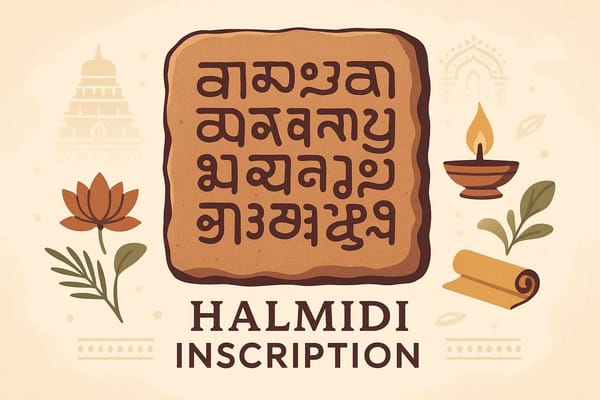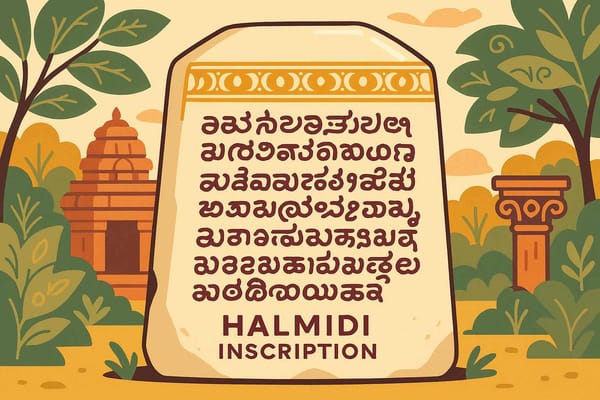
Halmidi Inscription- Solve the Mysteries of Ancient Kannada
Have you ever stopped to think about the words you speak every day? The language that flows from us so effortlessly is a river that has travelled through centuries, carrying with it the stories, emotions, and wisdom of our ancestors. For those of us who speak Kannada, there is a special place, a single stone, that marks the very source of this written river. This is the story of the Halmidi inscription (ಹಲ್ಮಿಡಿ ಶಾಸನ), a silent witness to the birth of written Kannada.
Imagine stumbling upon a simple stone slab in a quiet village, only to realize you are holding the key to your land's ancient linguistic past. It’s a feeling that sends shivers down your spine, connecting you directly to a time long forgotten.
A Discovery That Rewrote History
The year was 1936. In the serene village of Halmidi, nestled in Karnataka's Hassan district, Dr. M.H. Krishna made a discovery that would forever change our understanding of Kannada's history. He found a sandstone pillar, about 4 feet tall, with ancient engravings. This wasn't just any old carving; it was the earliest known evidence of the Kannada language being used for official purposes.
Before this incredible find, many believed that Sanskrit was the sole language of administration and royalty during that era. But the Halmidi inscription, dated between 450 and 500 CE, proved everyone wrong. It was a powerful declaration that Kannada was not just a spoken dialect but a language of governance and power, holding its own under the great Kadamba Dynasty. This single stone pushed back the recorded history of our language by centuries!
So, What Exactly is this Ancient Stone Telling Us?
The inscription is a beautiful piece of history carved in what scholars call Proto-Kannada, a very early form of the language, written in a script influenced by Brahmi. It’s not a poem or a story, but a royal record that gives us a peek into the society of that time.
The text on the stone is a royal grant. It speaks of a fierce battle and honours a brave warrior named Vija Arasa for his heroism. As a reward for his valour, the Kadamba king Kakusthavarman gifted him the villages of Palmaḍi (modern-day Halmidi) and Mūḷivaḷḷi. The very first line is a prayer, an invocation to Lord Vishnu, showing how faith and governance were beautifully intertwined. This blend of administrative record-keeping and spiritual invocation shows a deep connection between spirituality and ancient wisdom that defined the era.
The Enduring Legacy of Our Oldest Written Record
The Halmidi inscription is more than just an old rock; it’s a foundational document of Kannada identity and a testament to the rich cultural tapestry of early Karnataka. Its historical significance is immense for several reasons:
- Proof of Administrative Kannada: It stands as the first official proof that Kannada was the language of the land. It wasn't just spoken in homes but was used to issue royal orders, grant land, and run an entire kingdom. This highlights the deep roots of the language in the region's governance.
- A Window into Script Evolution: For language lovers and historians, the inscription is a treasure trove. It shows the evolution of the Kannada script from the ancient Brahmi script, capturing a pivotal moment in our linguistic journey. It helps us trace how the beautiful, rounded letters of modern Kannada came to be.
- A Glimpse of Kadamba Life: The inscription tells a story of kings, warriors, and a society that valued bravery and rewarded it. It offers precious insights into the social and political structure during the Kadamba dynasty, helping us understand our past in a more personal way, much like the tales of valour found in the history of other ancient Indian kingdoms.
Where can you see this historical marvel?
Understandably, a treasure of this magnitude needs to be protected. The original Halmidi inscription is carefully preserved at the Office of the Director of Archaeology and Museums in Mysore. However, to ensure that everyone can experience this piece of our heritage, a faithful fiberglass replica has been installed in Halmidi village for public viewing, standing proudly where it was first discovered.
Connecting With Our Roots in a Digital World
The Halmidi inscription is a powerful reminder of the importance of preserving our heritage. It connects us to our roots and inspires us to cherish the language and traditions passed down to us. In today's fast-paced world, it's easy to lose touch with these timeless treasures.
That's where we at Bhaktilipi come in. Just as archaeologists preserve physical artifacts, we are dedicated to preserving, reimagining, and sharing the timeless devotional literature and stories that form the soul of our culture. We believe that these stories, much like the Halmidi inscription, hold the key to understanding who we are.
Why Choose Bhaktilipi?
- Authentic and Curated Content: We provide you with carefully selected bhakti literature, stories, and insights, ensuring you receive authentic knowledge. We delve into the history of our traditions, exploring artifacts like the Halmidi inscription to understand the context of our spiritual heritage.
- A Bridge to Tradition: Our platform makes it easy to connect with the rich heritage of bhakti from across India. We bring you the wisdom of the ages in a format that inspires and fits into your modern life, all with the convenience of digital access.
Come, join our community and embark on a journey of discovery. Subscribe to our newsletter, and follow us on Facebook and Instagram to stay connected to your roots. Let's celebrate and protect these timeless treasures together.
A passionate group of people dedicated to preserving India's knowledge of Dharma, Karma, and Bhakti for ourselves and the world 🙏.
Comments
Related in

Understanding the Halmidi Inscription: Examines India's Oldest Kannada Script
Have you ever held an old letter from your grandparents? The faded ink, the delicate paper, it feels like you're holding a piece of their soul, a direct connection to your roots. Now, imagine finding a letter not from a grandparent, but from our ancestors who lived over

Halmidi Inscription: Kannada Literature's Dawn Explored
Imagine walking through a quiet village in Karnataka, the air filled with the familiar sounds and smells of home. In such a simple, unassuming place called Halmidi, in the Hassan district, a piece of our history lay waiting. A stone slab, which turned out to be not just any stone,

Halmidi Inscription: Ancient Karnataka Speaks Through Stone
Have you ever walked past an old stone carving or a temple wall and felt a pull, a sense that it has stories to tell? India is a land of such whispers from the past. Every corner holds a secret, etched in stone, waiting for someone to listen. One such
